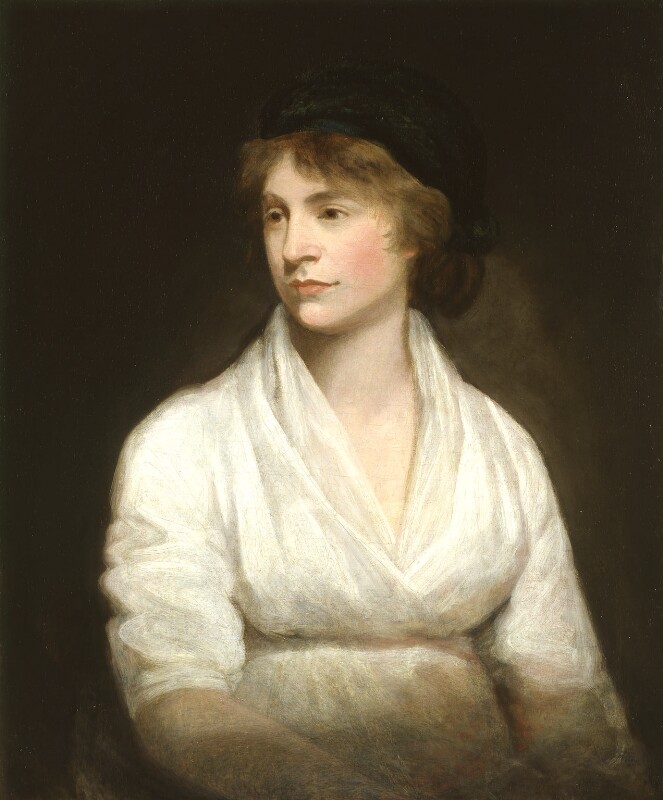
The feminist icon Mary Wollstonecraft is best known as the author of A Vindication of the Rights of Woman (1792), a pioneering argument for women’s rights.
In the 1980s, I, a New Yorker, fought London’s National Portrait Gallery to see that a compelling portrait of Wollstonecraft was finally put on display.
Today, the Mary on the Green Campaign—which notes that more than 90 percent of London’s monuments are of men—has created a sculpture memorial honoring Wollstonecraft that will be unveiled and dedicated in 2020 in London’s Newington Green.
Below is my original article, “Liberating Mary,” which appeared in the fall 2004 issue of Ms. on pp. 72-73:
No visit to London can really begin for me until I go to the National Portrait Gallery, near Trafalgar Square, and pay my respects to a lovely painting of Mary Wollstonecraft that I helped “liberate” from the gallery’s “dungeons.”
The seeds of my rescue began in the late 1970s, when I visited the gallery but couldn’t find a painting of Wollstonecraft. A few years earlier, my men’s study group on early feminist literature had devoted six months to the life and work of the inspiring English writer of the late 18th century, best known for A Vindication of the Rights of Woman.
I subsequently lectured at women’s studies classes about this eloquent crusader who offered challenging political insights and was bold enough to attack in print some of the most famous men of her time, among them Burke, Rousseau, and Talleyrand.
Because of my great admiration for Wollstonecraft, she was on my mind when I walked through the National Portrait Gallery and then stopped at the gift shop. In a most unlikely place—the “G” section of the postcards—I suddenly recognized a postcard of her labeled “Mary Godwin (nee Wollstonecraft).” In her 30s, Wollstonecraft had married the British philosopher William Godwin but had continued to use and write under her own name. The National Portrait Gallery either hadn’t noticed or didn’t approve.
The postcard indeed featured a portrait of Wollstonecraft, but where was the painting itself? At the information desk, I learned that the portrait (by John Opie, circa 1797) was currently housed in the storage area. The gallery’s walls included few paintings of women—most of whom were best known for some biological or romantic connection to a famous man. At the same time, there was apparently no room for a portrait of England’s feminist pioneer.
The story might have ended there, but the woman at the information desk volunteered that a visitor could request to see any painting not on display. The timing was right, a guard was found, and I was soon down in a storage room standing before Opie’s striking portrait.
The painting shows Wollstonecraft in simple clothing: a black beret and a loose white blouse—without any of the lacy feminine frills of that era. She seems intelligent, serene, hardly the dangerous radical so vilified by her enemies. Against a dark background, a single light source brilliantly illuminates Wollstonecraft’s face and blouse, as if the artist saw Wollstonecraft’s burning feminist spirit as a beacon of truth amidst the prejudice and ignorance around her.
During visits to London over the next few years, I retraced those steps to see Opie’s portrait and lamented that others wouldn’t get that opportunity. In early 1984, however, I quite literally encountered an obstacle. A guard said I couldn’t see the painting because there was “something in the way.” The assistant registrar, Andrea Gall, was called in and countered: “So let’s move it!” We did, and as we admired the portrait together, we wondered why it was not on display.
The time had come to protest Wollstonecraft’s imprisonment. I requested a meeting with Jacob Simon, the new curator for the gallery’s 18th century collection. When we spoke in his office, I urged him to find room for the painting and to label it just as she is remembered, Mary Wollstonecraft. He was polite but noncommittal.
Later that year, Mr. Simon sent me a carefully worded letter stating that the Wollstonecraft portrait would soon go on display—but only for four months, to take the place of a painting of Wordsworth on loan to another museum. Thrilling as this news was, I was also saddened because I wouldn’t be in London again during those months and thus would never see the fruits of my protest. Then, shortly thereafter, I learned that the portrait had been cleaned, given an impressive new frame, and was now hanging for all to see… under the name of Mary Wollstonecraft!
Now I regretted even more that I’d never see the portrait on the gallery’s walls. But when the Wordsworth painting returned to its home in early 1985, I received stunning news and Jacob Simon became a true hero. Despite his original plan, he never took down the portrait of Wollstonecraft and it has remained on display ever since.
She can be found today in a small room with stained wooden floors, along with portraits of her husband, William Godwin, and their daughter, Mary Shelley. (Wollstonecraft died in 1797 shortly after giving birth to the younger Mary, best known as the author of Frankenstein.) Wollstonecraft and her loved ones look out proudly on an illustrious array of companions: Percy Shelley, Wordsworth, Keats, Byron, Coleridge, Blake, and Austen.
Virginia Woolf wrote of Wollstonecraft: “One form of immortality is hers undoubtedly: she is alive and active, she argues and experiments, we hear her voice and trace her influence even now among the living.”
And, I’m delighted to say, we see her portrait as well.
Copyright © Bob Lamm 2003. Published by Ms. Magazine, fall 2004.
You may also like:





